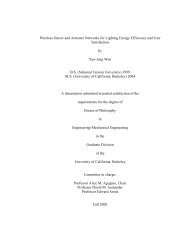features. Using the first 10 PCs leads to a classification per<strong>for</strong>mance improvement.However, further increasing the number of PCs from 10 to 30 does not gain anything inclassification per<strong>for</strong>mance.Table I: Classification accuracies summaryClassification accuracyMethods Mean Std. Dev. Min. Max.All 88 features 0.9566 0.0206 0.9224 0.9811PCA3 0.9644 0.0055 0.9560 0.970610 0.9839 0.0044 0.9748 0.987430 0.9813 0.0036 0.9748 0.9874LDA 0.9906 0.0048 0.9832 0.9958The LDA results: The PD diagnostic system concerned in this paper is a 2-classclassification problem, with the 2 classes being either normal or chafed condition ofaircraft wires. As discussed in Section 2, the maximal number of new features in LDAspace is equal to the number of classes minus one. Thus applying LDA to the 88 featuresextracted in Section 3 results in a single feature in the LDA space. The distributions ofthe single LDA feature over the 2 wiring conditions (normal and chafed) are show inFigure 3. It clearly shows a good separation between the 2 conditions/classes, whichmeans that the LDA feature carries high discriminant power, thus expects to give a goodclassification per<strong>for</strong>mance.Figure 3: <strong>Feature</strong> value distribution of the LDA featureThe classification accuracies <strong>for</strong> the design using the LDA feature are also shown inTable I (last row). Using the single LDA feature achieves the highest classificationaccuracies.From Table I, we can see that both PCA and LDA not only dramatically reduce thenumber of features needed by the classifier, but also improve the classification
per<strong>for</strong>mance <strong>for</strong> the PD diagnosis problem. Between the two linear trans<strong>for</strong>mationmethods (PCA and LDA), LDA seems to be more effective not only in reducing feature<strong>dimensionality</strong>, but also in improving classification per<strong>for</strong>mance. This observation, i.e.,LDA is better that PCA in classification, is accordance with the intuition. Theobservation from Table I that both PCA and LDA use a few features while showingbetter per<strong>for</strong>mance than the design using all 88 features indicates that there exist a greatnumber of redundant features among the original 88 features, which is expected since the5 different feature extraction methods used are not necessarily independent.5. Conclusions: In designing PD diagnostic systems and any other diagnostic systemsalike, finding an optimal feature set with a smaller number of features is important. Thispaper is concerned with using linear feature trans<strong>for</strong>mation to reduce feature<strong>dimensionality</strong>. More specifically, we investigate the effectiveness of linear featuretrans<strong>for</strong>mation on improving the classification per<strong>for</strong>mance of PD diagnostic systems. Byusing an example of designing a PD diagnostic system <strong>for</strong> aircraft wire fault diagnosis,this paper demonstrates that both PCA and LDA can be effective not only in reducingfeature <strong>dimensionality</strong>, but also in improving the classification per<strong>for</strong>mance, in the designof PD diagnostic systems <strong>for</strong> aircraft wiring. There<strong>for</strong>e, linear feature trans<strong>for</strong>mation(PCA and LDA), especially when working together with our proposed 2-step featureextraction approach, can be potentially useful in design of PD diagnostic systems. Thispaper also demonstrates that LDA outper<strong>for</strong>ms PCA <strong>for</strong> PD diagnosis because theunderlying objective <strong>for</strong> LDA is specifically to maximize class separability.ACKNOLEGEMENT: The authors gratefully acknowledge the guidance and support ofNicole Evers, Janos Sarkozi and Karim Younsi at GE Global Research Center and ofSean Field, Charles Fulbright, and Greg Nepini at NavAir. This work was funded byONR under contract #: N00014-02-C-0402.REFERENCES:1. Gulski, E. (1995), “Digital analysis of <strong>partial</strong> discharges”, IEEE Transactions onDielectrics and Electrical Insulation, Vol. 2, No. 5, pp822-37.2. Gulski, E., Burger, H.P., Zielonka, A., and Brooks, R. (1996), “Classification ofdefects in HV components by fractal analysis of PD measurements”, IEEE AnnualReport Conference on Electrical Insulation and Dielectric Phenomena, San Francisco,October 20-23, 19963. Abdul Rahman, M.K., Arora, R., and Srivastava, S.C. (2000), “Partial dischargeclassification using principal component trans<strong>for</strong>mation”, IEE Proceedings ofScientific Measurement Technologies, Vol. 147, No. 1, pp7-134. Yan, W. & Goebel, K. (2005), “<strong>Feature</strong> selection <strong>for</strong> <strong>partial</strong> discharge diagnosis”,Submitted to SPIE Smart Structures 2005, March 6 –10, San Diego, CA5. Fodor, I.K. (2002), “A survey of dimension <strong>reduction</strong> techniques”, LawrenceLivermore National Laboratory (LLNL) technical report, June 2002, UCRL-ID-1484946. Duda, R. O., Hart, P. E., and Stork, D. G. (2000), Pattern Classification, John Wiley& Sons, Inc., New York, NY
















